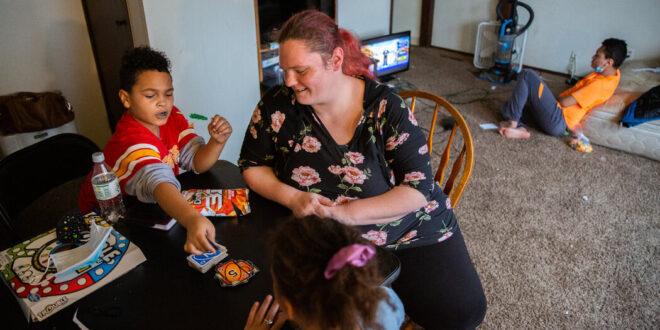Mothers and advocates for families cite a long list of policy frustrations. Congress declined to mandate paid leave in the stimulus bill, opting instead to extend a tax credit to employers who voluntarily offer the policy. While the relief bill included money for school reopenings, the support has not been well-targeted and comes toward the end of the school year. And it remains unclear whether the administration will push for the child care tax credit to be made permanent.
“Moms are getting screwed on the right or the left. I don’t feel like anyone is out there fighting for us,” said Reshma Saujani, the founder and chief executive of Girls Who Code, a group that works to attract more young women to become programmers and engineers. “There is an enormous amount of populist mom rage and I don’t think that moms feel seen. Why aren’t the schools open now? Every day that goes by, another mother is losing their job. It’s not a priority.”
Ms. Saujani is the creator of the Marshall Plan for Moms, a package of policies funding paid leave, affordable child care and pay equity aimed at helping mothers who have struggled during the pandemic. While pieces of her plan have been introduced in Congress and were included in the relief bill, and have been embraced by policymakers, celebrities and activists, Ms. Saujani would like to see more attention paid to a situation she views as a national emergency.
“Absolutely everything is a struggle right now — getting sick days, getting my son to learn, getting help,” said Adriana Alvarez, a single mother of a 9-year-old, who works at a McDonald’s just outside Chicago and has significantly cut back her hours in the last year. “There has to be a solution that’s funded by the government to help people like me.”
For others who have pushed for these policies for years, the moment seems most ripe: If a pandemic is not enough to persuade lawmakers to pass policies like paid family leave, will anything ever convince them?
Frequently Asked Questions About the New Stimulus Package
The stimulus payments would be $1,400 for most recipients. Those who are eligible would also receive an identical payment for each of their children. To qualify for the full $1,400, a single person would need an adjusted gross income of $75,000 or below. For heads of household, adjusted gross income would need to be $112,500 or below, and for married couples filing jointly that number would need to be $150,000 or below. To be eligible for a payment, a person must have a Social Security number. Read more.
Buying insurance through the government program known as COBRA would temporarily become a lot cheaper. COBRA, for the Consolidated Omnibus Budget Reconciliation Act, generally lets someone who loses a job buy coverage via the former employer. But it’s expensive: Under normal circumstances, a person may have to pay at least 102 percent of the cost of the premium. Under the relief bill, the government would pay the entire COBRA premium from April 1 through Sept. 30. A person who qualified for new, employer-based health insurance someplace else before Sept. 30 would lose eligibility for the no-cost coverage. And someone who left a job voluntarily would not be eligible, either. Read more
This credit, which helps working families offset the cost of care for children under 13 and other dependents, would be significantly expanded for a single year. More people would be eligible, and many recipients would get a bigger break. The bill would also make the credit fully refundable, which means you could collect the money as a refund even if your tax bill was zero. “That will be helpful to people at the lower end” of the income scale, said Mark Luscombe, principal federal tax analyst at Wolters Kluwer Tax & Accounting. Read more.
There would be a big one for people who already have debt. You wouldn’t have to pay income taxes on forgiven debt if you qualify for loan forgiveness or cancellation — for example, if you’ve been in an income-driven repayment plan for the requisite number of years, if your school defrauded you or if Congress or the president wipes away $10,000 of debt for large numbers of people. This would be the case for debt forgiven between Jan. 1, 2021, and the end of 2025. Read more.
The bill would provide billions of dollars in rental and utility assistance to people who are struggling and in danger of being evicted from their homes. About $27 billion would go toward emergency rental assistance. The vast majority of it would replenish the so-called Coronavirus Relief Fund, created by the CARES Act and distributed through state, local and tribal governments, according to the National Low Income Housing Coalition. That’s on top of the $25 billion in assistance provided by the relief package passed in December. To receive financial assistance — which could be used for rent, utilities and other housing expenses — households would have to meet several conditions. Household income could not exceed 80 percent of the area median income, at least one household member must be at risk of homelessness or housing instability, and individuals would have to qualify for unemployment benefits or have experienced financial hardship (directly or indirectly) because of the pandemic. Assistance could be provided for up to 18 months, according to the National Low Income Housing Coalition. Lower-income families that have been unemployed for three months or more would be given priority for assistance. Read more.
Nearly 200 businesses signed on to a letter to congressional leaders last week urging them to include paid family and medical leave in the upcoming infrastructure package, which many believe is the best chance to get the policy approved by Congress. Liberal organizations and caregiver advocacy groups started their own $20 million campaign, called #CareCantWait, that is pushing the administration to expand access to child care, paid family and medical leave, as well as home and community-based services for people with disabilities and aging adults.
 Top Naija News: Nigerian News, Breaking News Nigeria and World News Top Naija News is a daily news publication in Nigeria, delivering the latest breaking news in Nigeria and around the world.
Top Naija News: Nigerian News, Breaking News Nigeria and World News Top Naija News is a daily news publication in Nigeria, delivering the latest breaking news in Nigeria and around the world.




